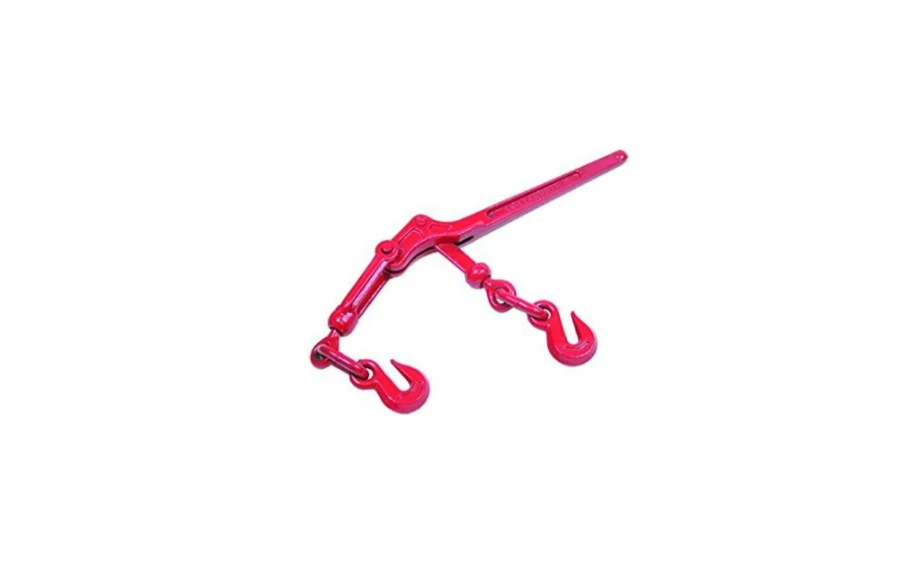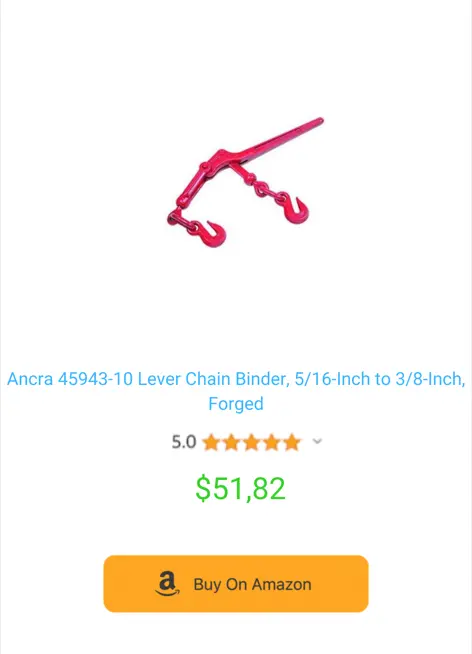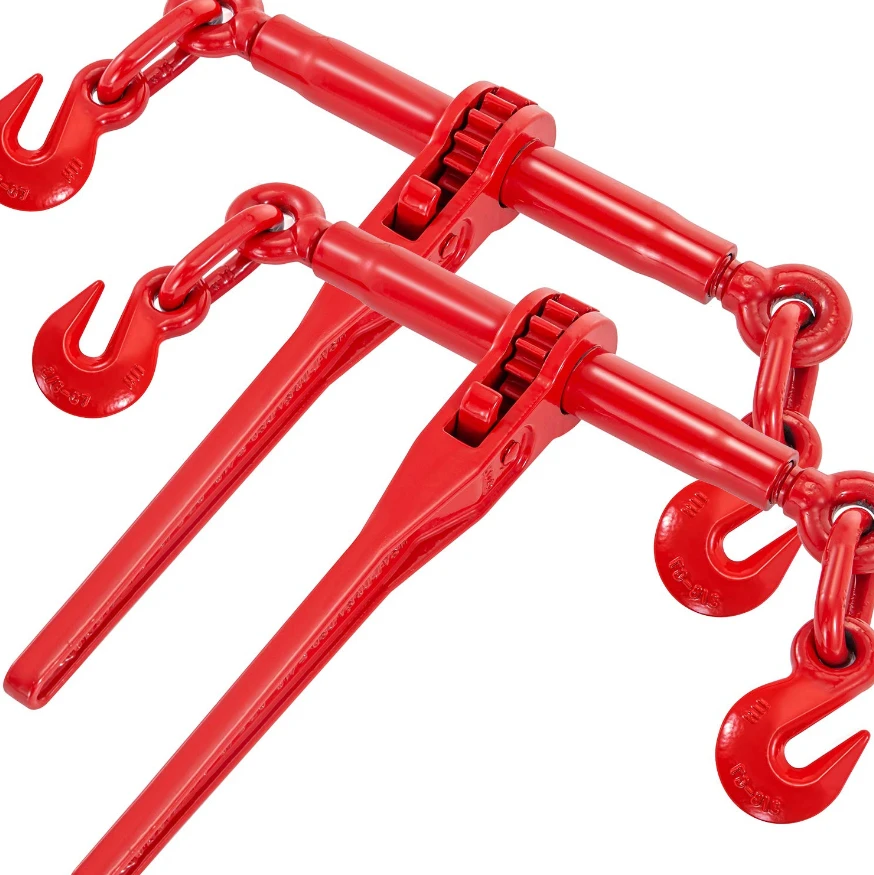If you are looking for a reliable and efficient way to secure heavy loads on your truck, trailer, or rail car, you might want to consider using a 3/8 chain binder. A chain binder, also known as a load binder, is a device that tightens and locks a chain around a load, preventing it from shifting or falling during transport. Chain binders are widely used in the transportation industry, as well as in the marine, agricultural, and construction sectors.
In this guide, we will explain what a 3/8 chain binder is, how it works, what are its benefits, and how to choose the best one for your needs. We will also provide some tips on how to use and maintain a chain binder safely and effectively. Finally, we will review some of the best 3/8 chain binders available on Amazon, and why you should buy them through our affiliate links.
What is a 3/8 Chain Binder?
A 3/8 chain binder is a type of chain binder that is designed to work with 3/8 inch chains. Chains are measured by the thickness of their links, and 3/8 inch is one of the most common sizes used for securing heavy loads. Chains are also graded by their strength and durability, and the most widely used grade for transport applications is Grade 70, also known as transport chain or binder chain.
A 3/8 chain binder consists of two hooks, a handle, and a ratchet or lever mechanism. The hooks are attached to the ends of the chain, and the handle is used to tighten or loosen the chain. The ratchet or lever mechanism allows the user to adjust the tension of the chain and lock it in place. Depending on the type of mechanism, there are two main kinds of chain binders: ratchet chain binders and lever chain binders.
Ratchet Chain Binders
A ratchet chain binder uses a rotating motion to tighten and secure the chain. It has a ratchet wheel and a pawl that engages with the teeth of the wheel, preventing it from reversing. To use a ratchet chain binder, the user attaches the hooks to the chain and rotates the handle until the desired tension is reached. Then, the user releases the handle and the pawl locks the ratchet wheel in place. To release the chain, the user lifts the pawl and rotates the handle in the opposite direction.
Ratchet chain binders have several advantages over lever chain binders. They are easier and safer to operate, as they do not require a lot of force or a handle lock to secure the chain. They also allow for more precise and gradual adjustment of the chain tension, which reduces the risk of over-tightening or under-tightening the chain. Moreover, they are more stable and durable, as they have fewer moving parts and less wear and tear.
Lever Chain Binders
A lever chain binder uses a lever action to tighten and secure the chain. It has a lever handle and a toggle that locks the handle in place. To use a lever chain binder, the user attaches the hooks to the chain and pulls the handle until the desired tension is reached. Then, the user flips the toggle and the handle locks in place. To release the chain, the user flips the toggle again and pushes the handle in the opposite direction.
Lever chain binders have some advantages over ratchet chain binders. They are faster and simpler to use, as they do not require a lot of rotation or a pawl to secure the chain. They also have a higher mechanical advantage, which means they can generate more force with less effort. However, they also have some disadvantages. They are harder and more dangerous to operate, as they require a lot of force and a handle lock to secure the chain. They also do not allow for fine adjustment of the chain tension, which increases the risk of over-tightening or under-tightening the chain. Furthermore, they are less stable and durable, as they have more moving parts and more wear and tear.
What are the Benefits of Using a 3/8 Chain Binder?
Using a 3/8 chain binder has many benefits for securing heavy loads. Some of the main benefits are:
- Strength and Durability: A 3/8 chain binder, when used with a 3/8 Grade 70 chain, can handle loads up to 9,200 lbs, which is more than enough for most transport applications. A 3/8 chain binder is also made of high-quality steel, which makes it resistant to corrosion, abrasion, and impact.
- Versatility and Flexibility: A 3/8 chain binder can be used with different types of loads, such as lumber, steel, machinery, vehicles, and more. A 3/8 chain binder can also be used with different types of anchor points, such as stake pockets, D-rings, eye bolts, and more. A 3/8 chain binder can also be adjusted to fit different sizes and shapes of loads, as well as different lengths and widths of chains.
- Safety and Security: A 3/8 chain binder can prevent the load from shifting or falling during transport, which can cause damage, injury, or accidents. A 3/8 chain binder can also comply with the cargo securement standards set by the US Department of Transportation (DOT), which require that the load be secured with a minimum of four chains and binders, and that the chain tension be checked and adjusted regularly.
How to Choose the Best 3/8 Chain Binder for Your Needs?
Choosing the best 3/8 chain binder for your needs depends on several factors, such as the type, size, and weight of your load, the type and length of your chain, the type and availability of your anchor points, and your personal preference and budget. Here are some tips on how to choose the best 3/8 chain binder for your needs:
- Choose the Right Type of Chain Binder: As we explained earlier, there are two main types of chain binders: ratchet chain binders and lever chain binders. Each type has its pros and cons, and you should choose the one that suits your needs and preferences better. Generally speaking, ratchet chain binders are easier, safer, and more precise to use, but they are also more expensive and heavier than lever chain binders. Lever chain binders are faster, simpler, and cheaper to use, but they are also harder, more dangerous, and less accurate to use.
- Choose the Right Size of Chain Binder: The size of the chain binder refers to the size of the chain that it can work with. You should choose a chain binder that matches the size of your chain, otherwise, it will not fit or function properly. For example, if you have a 3/8 inch chain, you should choose a 3/8 chain binder, not a 1/2 chain binder or a 5/16 chain binder. The size of the chain binder is usually marked on the handle or the body of the binder.
- Choose the Right Grade of Chain Binder: The grade of the chain binder refers to the strength and durability of the binder. You should choose a chain binder that matches the grade of your chain, otherwise, it will not be able to handle the load or withstand the stress. For example, if you have a Grade 70 chain, you should choose a Grade 70 chain binder, not a Grade 43 chain binder or a Grade 30 chain binder. The grade of the chain binder is usually marked on the handle or the body of the binder.
- Choose the Right Number of Chain Binders: The number of chain binders refers to the number of binders that you need to secure your load. You should choose enough chain binders to meet the cargo securement standards set by the US DOT, as well as your own safety and security requirements. Generally speaking, you need at least four chain binders to secure a load, one for each corner of the load. However, depending on the type, size, and weight of your load, you may need more chain binders to distribute the load evenly and prevent it from shifting or falling. You should also consider the type and availability of your anchor points, as they may limit the number and placement of your chain binders.
How to Use and Maintain a 3/8 Chain Binder Safely and Effectively?
Using and maintaining a 3/8 chain binder safely and effectively requires some knowledge and skills, as well as some precautions and care. Here are some tips on how to use and maintain a 3/8 chain binder safely and effectively:
- Read and Follow the Instructions: Before using a 3/8 chain binder, you should read and follow the instructions provided by the manufacturer or the seller. The instructions will tell you how to attach, tighten, release, and store the chain binder, as well as the specifications, limitations, and warnings of the chain binder. You should also check the labels and markings on the chain binder, such as the size, grade, working load limit, and break strength, and make sure they match your chain and load.
- Wear Protective Gear: When using a 3/8 chain binder, you should wear protective gear, such as gloves, goggles, boots, and helmets, to protect yourself from injuries. Chain binders can be heavy, sharp, and hot, and they can cause cuts, bruises, burns, or eye damage if mishandled. You should also avoid wearing loose clothing, jewelry, or hair that can get caught in the chain binder or the chain.
- Inspect the Chain Binder: Before using a 3/8 chain binder, you should inspect the chain binder for any signs of damage, wear, or corrosion. You should look for cracks, bends, breaks, or rust on the hooks, handle, or mechanism. You should also check the function and alignment of the ratchet or lever mechanism, and make sure it can tighten and release the chain smoothly and securely. If you find any defects or problems with the chain binder, you should replace it immediately, as it may compromise the safety and performance of the chain binder.
- Attach the Chain Binder Properly: When attaching a 3/8 chain binder to a chain and a load, you should follow the proper procedure and technique. You should first lay out the chain around the load and the anchor points, and make sure it is not twisted, tangled, or kinked. You should then hook the chain binder to the chain, making sure the hooks are fully engaged and facing the right direction. You should also leave some slack in the chain, as you will need it to tighten the chain later. You should then tighten the chain binder according to the type of mechanism, as we explained earlier. You should apply enough tension to the chain to secure the load firmly, but not too much to damage the chain or the load. You should also check the working load limit and the break strength of the chain and the chain binder, and make sure you do not exceed them.
- Release the Chain Binder Carefully: When releasing a 3/8 chain binder from a chain and a load, you should follow the proper procedure and technique. You should first release the chain binder according to the type of mechanism, as we explained earlier. You should be careful not to let the handle snap back, as it may cause injury or damage. You should then unhook the chain binder from the chain, making sure the hooks are fully disengaged and facing the right direction. You should also be careful not to drop the chain or the chain binder, as they may be heavy and hot. You should then coil the chain and store it in a dry and clean place, along with the chain binder.
- Clean and Lubricate the Chain Binder Regularly: To extend the life and performance of a 3/8 chain binder, you should clean and lubricate it regularly. You should remove any dirt, dust, grease, or grime from the chain binder, using a cloth, a brush, or a solvent. You should also apply a thin layer of oil or grease to the moving parts of the chain binder, such as the hooks, the handle, and the mechanism. This will prevent rust, corrosion, and friction, and ensure smooth and easy operation of the chain binder.
What are the Best 3/8 Chain Binders Available on Amazon?
If you are looking for the best 3/8 chain binders available on Amazon, we have selected some of the top-rated and best-selling products for you. These products have received positive feedback from customers who have used them for securing heavy loads. They also offer great features, quality, and value for money. Here are some of the best 3/8 chain binders available on Amazon, and why you should buy them through our affiliate links:
Ancra 45943-10 Ratchet Chain Binder
The Ancra 45943-10 Ratchet Chain Binder is a high-quality and durable chain binder that can handle loads up to 9,200 lbs. It has a forged steel handle and hooks, and a cast steel ratchet wheel and pawl. It also has a self-locking design that prevents the handle from reversing or loosening. The Ancra 45943-10 Ratchet Chain Binder is easy and safe to use, as it allows for precise and gradual adjustment of the chain tension. It also complies with the DOT and CVSA standards for cargo securement.
The Ancra 45943-10 Ratchet Chain Binder is available on Amazon for $49.99. If you buy it through our affiliate link, you will get a 10% discount, and we will get a small commission that helps us keep providing you with helpful and informative content. Click here to buy the Ancra 45943-10 Ratchet Chain Binder on Amazon.
DC Cargo Heavy-Duty Chain Binder
The DC Cargo Heavy-Duty Chain Binder is a value pack that includes four ratchet chain binders that can handle loads up to 6,600 lbs each. They have forged steel handles and hooks, and cast steel ratchet wheels and pawls. They also have self-locking designs that prevent the handles from reversing or loosening. The DC Cargo Heavy-Duty Chain Binder is easy and safe to use, as they allow for precise and gradual adjustment of the chain tension. They also comply with the DOT and CVSA standards for cargo securement.
The DC Cargo Heavy-Duty Chain Binder is available on Amazon for $85.99. If you buy it through our affiliate link, you will get a 10% discount, and we will get a small commission that helps us keep providing you with helpful and informative content. Click here to buy the DC Cargo Heavy-Duty Chain Binder.
FAQ
Here are some of the frequently asked questions about 3/8 chain binders, and their answers:
- Q: How do I know what size of chain binder I need?
- A: You need to know the size of your chain, and choose a chain binder that matches it. For example, if you have a 3/8 inch chain, you need a 3/8 chain binder. The size of the chain binder is usually marked on the handle or the body of the binder.
- Q: How do I know what grade of chain binder I need?
- A: You need to know the grade of your chain, and choose a chain binder that matches it. For example, if you have a Grade 70 chain, you need a Grade 70 chain binder. The grade of the chain binder is usually marked on the handle or the body of the binder.
- Q: How do I know how many chain binders I need?
- A: You need to know the type, size, and weight of your load, and choose enough chain binders to secure it. Generally speaking, you need at least four chain binders to secure a load, one for each corner of the load. However, depending on the type, size, and weight of your load, you may need more chain binders to distribute the load evenly and prevent it from shifting or falling. You should also consider the type and availability of your anchor points, as they may limit the number and placement of your chain binders.
- Q: How do I know how much tension to apply to the chain binder?
- A: You need to apply enough tension to the chain binder to secure the load firmly, but not too much to damage the chain or the load. You should also check the working load limit and the break strength of the chain and the chain binder, and make sure you do not exceed them. The working load limit is the maximum load that the chain or the chain binder can handle safely, and the break strength is the maximum load that the chain or the chain binder can handle before breaking. The working load limit and the break strength are usually marked on the chain or the chain binder, or provided by the manufacturer or the seller.
- Q: How do I check and adjust the chain binder during transport?
- A: You need to check and adjust the chain binder regularly during transport, as the chain may loosen or tighten due to the movement, vibration, or temperature of the load. You should check the chain binder before, during, and after each trip, and whenever you stop or change direction. You should also check the chain binder every 50 miles or every 3 hours, whichever comes first, according to the DOT and CVSA standards. You should adjust the chain binder according to the type of mechanism, as we explained earlier, and make sure the chain is tight and secure.






